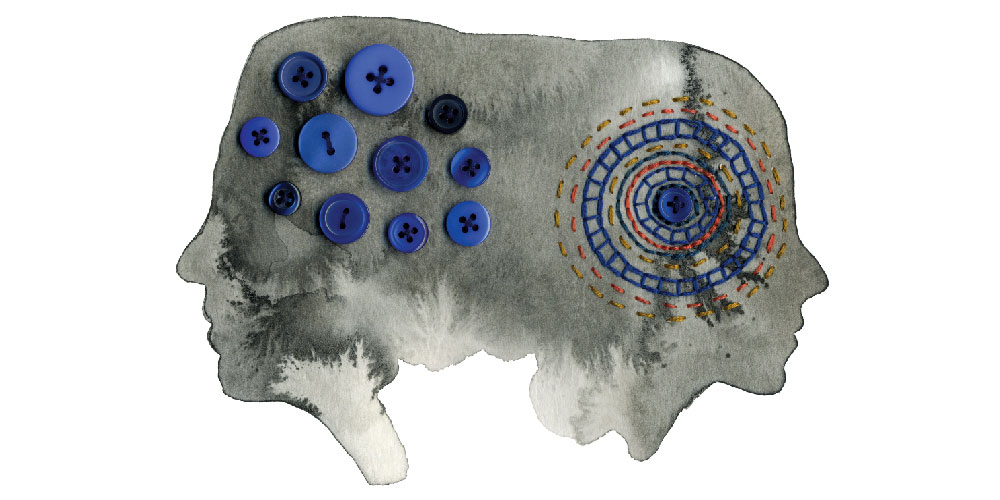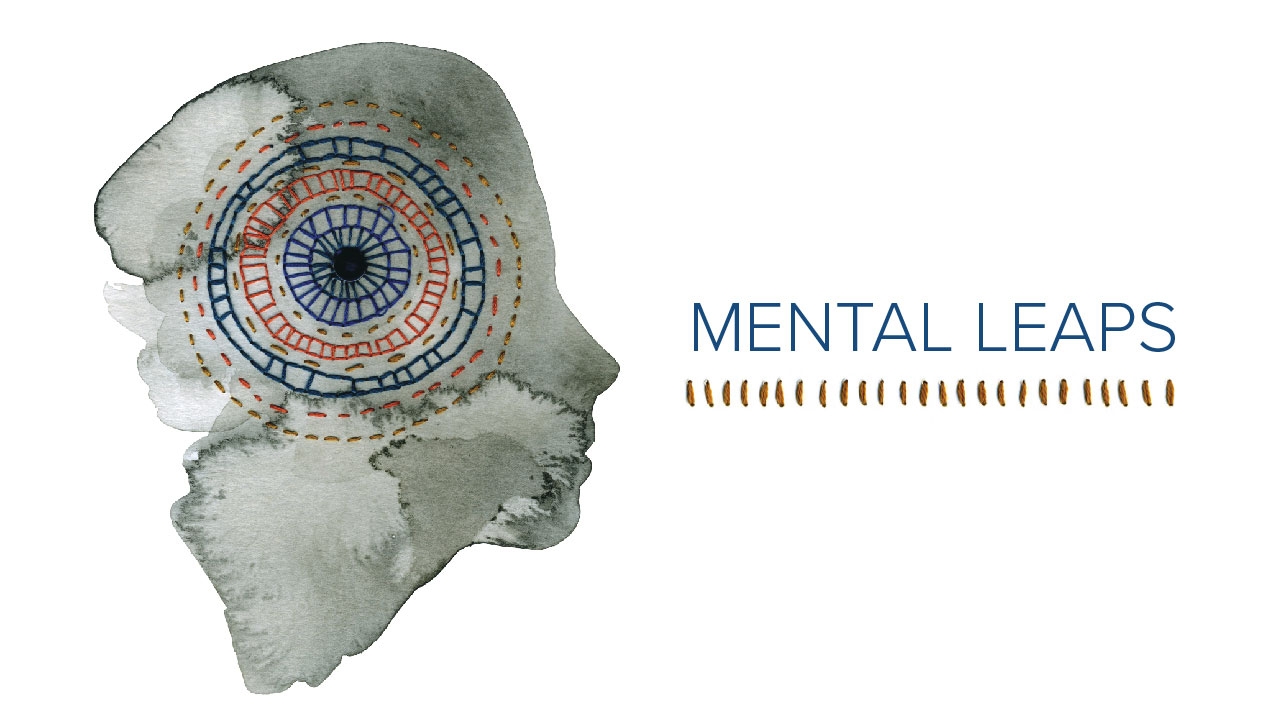Chances are, someone you know or love is dealing with depression or another form of mental illness. One in five adults—44.7 million people—in the United States do, according to a National Institute of Mental Health (NIMH) report of 2016 data. But it’s also likely that your friend or loved one is suffering alone. The NIMH report notes that less than half of those with a mental illness—19.2 million—had received treatment in the previous year.
This chasm in care exists, in part, because of lack of access to mental health counseling and treatments. Stigma—the fear or embarrassment of what others might think—also plays a role. UAB clinicians and researchers are working on both fronts, in partnership with agencies throughout the state, to lower barriers to care for Alabamians. Here, a few of these experts describe efforts that could change the course of mental health care—and offer ideas on ways you can help.
One in five children and youth suffer from mental, behavioral, or emotional disorders—and one in 10 have mental disorders serious enough to impact their functioning at home, at school, and in the community.
Source: Association for Children’s Mental Health
Childhood emotional and behavioral problems interfere with both academic and social growth, says Sylvie Mrug, Ph.D., chair of the College of Arts and Sciences Department of Psychology. That puts children “at risk for adverse outcomes including disengagement from school and school drop-out,” she explains. And as adults, they can face “persistent, lifelong problems with mental health, relationships, and work.”

Mrug leads a study of an innovative solution to alter that course: a coaching model that could help local middle and high schools change their culture—the values, beliefs, interactions, and other elements that shape a school’s environment—to improve students’ emotional and behavioral outcomes. Her partners include Fairfield City Schools, the Alabama School of Fine Arts, and the Birmingham nonprofit AlaQuest Collaborative for Education (ACE).
Initially, researchers will survey students, parents, teachers, school staff, and administrators to understand how well students do with issues such as self-management, emotion regulation, and social awareness. They also will examine existing student support systems, teacher-student interactions, student and family engagement, and school safety while gauging teachers’ readiness to support students’ social and emotional learning. Then ACE will review its large database of evidence-based programs to select interventions to match each school’s needs, Mrug says.
“Based on the survey results,” Mrug explains, “a school coach will work with each school’s ‘culture team’ to identify strengths and weaknesses, develop a strategy for improving school culture, and coach the school on implementing selected programs.
“We hope this project will increase awareness of the importance of school culture and students’ social-emotional learning and that it will start the change process,” she adds.
Alabama ranks 50th in the United States in access to mental health care in a 2017 survey.
Source: Mental Health America
A major reason for that bottom ranking, says James Meador-Woodruff, M.D., the Heman E. Drummond Endowed Chair of Psychiatry in the School of Medicine, is Alabama’s shortage of mental health-care professionals, especially in psychiatry. Medical students often shy away from the field.
In fact, psychiatry is among the medical fields with the greatest shortages, Meador-Woodruff says. It is among the least lucrative, and medical students—facing large student debt—often choose more procedure-based fields that pay more. “Also, a fair amount of psychiatric illness is stigmatized,” which discourages some students from the specialty, he notes.
But the School of Medicine is taking action to attract more students into psychiatry and the broader field of mental health care, Meador-Woodruff says. For example, medical students can volunteer in a student-run psychiatry clinic, where they work under the supervision of residents and attending physicians including Meador-Woodruff.
“Students get this wonderful interaction” with patients, who “get to see the same provider in a busy academic environment,” Meador-Woodruff says. “We have a group of about 25 medical students who come to the clinic, and the number of students selecting psychiatry as a specialty has almost doubled.”
Even for those selecting other specialties, the clinic has helped “make psychiatric patients less mysterious,” Meador-Woodruff says. “We’ve surveyed the students, and their comfort with psychiatric patients is higher than it would have been otherwise, and the stigma level associated with psychiatric patients has gone down.” It’s an especially big “win” to see some of those students pursuing primary care, he adds, because “ultimately, most psychiatric care in the community isn’t done by psychiatrists, but in primary care.”

Relief in 24 hours
A brighter day may be on the horizon for patients with difficult-to-treat depression or thoughts of suicide. Scientists in UAB’s Mood Disorders Program, part of the School of Medicine Department of Psychiatry and Behavioral Neurobiology, helped establish that a low dose of ketamine, a drug traditionally used for anesthesia, can help many patients recover in about 24 hours. Previously, patients had to endure a long trial-and-error process to identify an effective treatment, says Richard Shelton, M.D., program director and the Charles Byron Ireland Chair of Psychiatric Research. Now the investigators are testing a nasal-spray version of the drug to make it more accessible to patients. They also are studying another drug, rapastinel, that acts similar to ketamine.
A $10-million fund-raising initiative is helping to grow UAB’s Depression and Suicide Program. Spearheaded by community supporters and launched with a $3-million gift from Raymond and Kathryn Harbert, the investment will accelerate Shelton’s research, strengthen clinical care, and enhance training for practitioners.

Alabama is one of 10 states—three in the South—facing mental health professional shortages
Source: Henry J. Kaiser Family Foundation
In fact, the report says Alabama has only about a quarter of the mental health professionals needed to serve its residents. “The wait times to get an appointment with someone with expertise in child and adolescent mental health are especially long,” says Teena McGuinness, Ph.D., C.R.N.P., chair of the Department of Family, Community, and Health Systems in the School of Nursing. “Sometimes upwards of six months.”
In response, the School of Nursing has woven mental health care training throughout its curriculum. Its popular two-year psychiatric nurse practitioner program provides specialized training in diagnosing and treating mental health disorders. In clinical settings, psychiatric nurse practitioners can interview and assess patients and prescribe psychiatric medications when needed.
The school also offers two postgraduate training programs to help new psychiatric nurse practitioners become proficient in care tailored to veterans or children and adolescents. The students benefit from UAB’s partnerships with Children’s of Alabama and the Birmingham Veterans Affairs (VA) Medical Center, McGuinness says.
For example, students focusing on child and adolescent mental health can work alongside health professionals at Children’s of Alabama as they treat youngsters with mental and emotional disorders due to abuse, neglect, or poor health. And at the VA Medical Center, students work under the supervision of VA psychiatrists, psychiatric nurse practitioners, and a psychopharmacology specialist as they learn to treat patients suffering from post-traumatic stress disorder, addiction, schizophrenia, and other mental disorders.
“The brilliance of these learning environments,” says McGuinness, “is that our students get a broad education on what’s possible because of the teamwork.”

Approximately 10 percent of pregnant women and 13 percent of women who have just given birth experience a mental disorder.
Source: World Health Organization
Women experience emotional as well as physical changes during and after pregnancy. But some new mothers find themselves enveloped by debilitating depression beyond the typical “baby blues.”
Teen mothers and adult moms lacking adequate financial and social supports are most vulnerable to depression than their better resourced counterparts, says Robin Lanzi, Ph.D., professor and graduate program director in the School of Public Health’s Department of Health Behavior.
To examine the link between depression and child and family outcomes, Lanzi conducted a study comparing 682 women. Participants included teens between the ages of 15 to 18 with no high school diploma or GED certificate and 286 adult women ages 22 to 35—divided between those with no formal education beyond high school and others with at least two years of college.Lanzi found that the teenagers experienced significantly higher rates of mild, moderate, and even severe depression than the two groups of adult women. She also learned that the mothers with severe depression had lower rates of social support from their own mothers and their baby’s father. Moreover, the mothers who experienced no depression displayed more “warmth and responsiveness” toward their children than other “less resourced” mothers, she says.

From those findings, Lanzi and her team have developed a screening tool, called Parenting Responsibility and Emotional Preparedness (PREP), that can spot early warning signs. During pregnancy, PREP can determine which teen mothers are at risk for depression—and those “most likely to engage in non-optimal parenting and provide poor quality home environments for their child’s first two years,” Lanzi says. “The PREP scores identified adolescent mothers with significantly elevated depressive symptoms and childhood trauma and lower scores of knowledge about infant development and maternal IQ.”
Currently, most prenatal care clinics don’t administer a standardized clinical tool to detect depression, Lanzi says. PREP—which is simple, costs little, and doesn’t stigmatize patients—could change that. It also could help ensure that young mothers get the help they need at the right time by prompting prenatal care professionals to initiate interventions and communicate with clinic staff providing well-child care.
A 2014 survey showed that 29 percent of respondents reported that they or a family member had been denied mental health care by insurance companies because it was not considered medically necessary. That's more than twice the percentage reporting denials of general medical care.
Source: National Alliance of Mental Illness
Clients at the UAB Community Counseling Clinic range from the elderly to children as young as 6 years old. But they all share something in common: “Here they can receive quality weekly or biweekly outpatient clinic services at a fee they can afford,” says Dayna Watson, Ph.D., a clinic faculty supervisor and assistant professor in the School of Education Department of Human Studies.
Cost is one of the biggest barriers to people accessing mental health counseling, Watson says. “Just about all of our clients are uninsured or underinsured,” she notes. The clinic bases fees on a sliding scale, from $5 to $30 per session, to help patients get the care they need.
The School of Education’s Counseling Program operates the clinic, with its graduate students—under the supervision of Watson and other faculty members—providing individual, group, family, and couples counseling to Jefferson County residents. Watson recently added play therapy for young children to the clinic’s services. “The natural language of the child is play,” she explains. “Instead of sitting and talking about things that are going on with them, being able to play through those scenarios in a therapeutic setting is the way they process.”
Watson hopes the Community Counseling Clinic is helping to remove the stigma surrounding mental illness by making it easier for local residents to access care. “People say things like, ‘I would never go to a counselor,’ or ‘I’m not crazy,’” Watson explains. “But the more we as a community can talk about these things together, the less shame there will be.”

Mental preparation
Clinically trained social workers play a major role in providing mental health services. In fact, more than 60 percent of mental health professionals fall into that category, according to the National Association of Social Workers. But there is a need for more. To train students to meet the demand, the College of Arts and Sciences Department of Social Work launched a unique-in-Alabama master’s program that emphasizes behavioral health. Students prepare for clinical and community practice, learning about effective interventions tailored to specific population groups and putting their knowledge to work through internships in health and mental health settings.

In a 2017 survey of college students, 60.9 percent said they had felt overwhelming anxiety in the previous 12 months, 39.3 indicated they had felt too depressed to function, and 51.7 percent reported feelings of hopelessness.
Source: National College Health Assessment
For most measurements, UAB’s results from the survey hewed close to the national data, says Angela Stowe, Ph.D., director of UAB Student Counseling Services and Wellness Promotion. For example, 56 percent of UAB students said they experienced overwhelming anxiety in the previous year. “The top mental health concern of college students today is anxiety, followed by depression and relationship concerns,” Stowe explains.
UAB students have free access to individual and group counseling through Student Counseling Services, located in the Student Health and Wellness Center. The staff is ready to help students address eating disorders, alcohol and drug abuse, gender transition, and LGBTQ issues, among other challenges, Stowe says. They also can assist students with crises including sexual assault and suicide prevention.

Recently, Student Counseling Services launched online tools that let students take mental health screenings; learn about stress, anxiety, and depression; or determine their risk factors for alcohol or marijuana abuse—anywhere and at any time. The new tools “are based on science and provide effective strategies and important information about the concerns they want help addressing,” Stowe explains. “We encourage students to take these screeners, print their results, and bring them in to talk with someone. All of our services are confidential, and we are happy to answer any questions.”
What can you do?
How can one person help improve the outlook for mental health care in the United States? Begin by doing your part to reduce stigma, say UAB’s experts. Prioritize mental health and speak openly about it with the people you love. Learn about mental health concerns, signs and symptoms, and prevention and treatment programs so that you can help those in need. “Talk with care and compassion,” Stowe says. “Be a safe, open, accepting place where people can have good and bad days, and it’s all OK. Validate that mental health impacts our productivity, our relationships, our daily functioning, and our future outlook.” Don’t forget to take care of your own mental health, too.
Other ways to help: Join forces with other advocates through the Birmingham chapter of the National Alliance on Mental Illness. Support legislative actions to improve mental health care and research funding. And give to UAB to expand vital research initiatives and patient care services.

For help with mental health
UAB Medicine: 800.UAB.8816
UAB Psychiatry Clinics: 205.934.7008
Community Counseling Clinic: 205.996.2414
UAB Students: 205.934.5816
UAB Employees: 205.934.2281

• Discover the opportunities for learning, research, and experience in the College of Arts and Sciences, the School of Education, the School of Medicine, the School of Nursing, and the School of Public Health.


